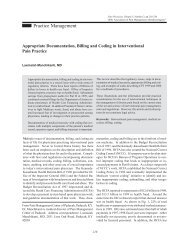ASIPP Practice Guidelines - Pain Physician
ASIPP Practice Guidelines - Pain Physician
ASIPP Practice Guidelines - Pain Physician
Create successful ePaper yourself
Turn your PDF publications into a flip-book with our unique Google optimized e-Paper software.
Manchikanti et al • <strong>ASIPP</strong> <strong>Practice</strong> <strong>Guidelines</strong><br />
26<br />
clinical practice guidelines is that they not only be systematically<br />
and scientifically developed but also should be able<br />
to assist practitioner and patient in making real life clinical<br />
decisions. The Institute of Medicine (IOM) implicitly<br />
incorporates rigorous science-based procedures as a part<br />
of the development of practice guidelines and decision<br />
making includes both clinicians and patients with a focus<br />
on specific clinical circumstances, without direction toward<br />
technology or procedures (6). The American Medical<br />
Association (AMA) uses the term practice parameter and<br />
defines this practice as “ . . . strategies for patient management,<br />
developed to assist physicians in clinical decision<br />
making. <strong>Practice</strong> parameters are highly variable in their<br />
content, format, degree of specificity, and method of development”<br />
(65). Thus, the methods that are used to develop<br />
practice guidelines vary among organizations and<br />
depend on objectives of the guideline and philosophic approach.<br />
Methods of development are classified as informal consensus<br />
development, formal consensus development, evidence-based<br />
guideline development, and explicit guideline<br />
development (5-7, 10, 65). However, a combination<br />
of multiple approaches is commonly utilized. Evidencebased<br />
guideline development provides a link between the<br />
strength of recommendations and the quality of evidence.<br />
Even though this approach may seem to have enhanced<br />
the scientific rigor of guideline development, recommendations<br />
may not always meet the highest scientific evidence<br />
(27).<br />
Evidence-based practice originated in the 50s with the advent<br />
of randomized, controlled trials. A randomized, controlled<br />
trial, also known as RCT, is a trial in which participants<br />
are randomly assigned to two groups: first, (experimental<br />
group) receiving the intervention that is being tested,<br />
and the other (the comparison or control group) receiving<br />
an alternative treatment or placebo. This design allows<br />
assessment of the relative effects of interventions. It is<br />
presumed that the strident debate between the proponents<br />
and opponents of evidence-based medicine has led to clarity<br />
(7). The current evidence-based medicine is defined as<br />
the conscientious, explicit, and judicious use of current best<br />
evidence in making decisions about the care of individual<br />
patients (10). The practice of evidence-based medicine<br />
requires the integration of individual clinical expertise with<br />
the best available external clinical evidence from systematic<br />
research. It should be construed that, apart from the<br />
results of the randomized controlled trials, there are many<br />
other factors that may weigh heavily in both clinical and<br />
policy decisions, such as patient preferences and resources,<br />
and these must contribute to decisions about the care of<br />
the patients (7). Thus, all evidence should be considered<br />
and no one sort of evidence should necessarily be the determining<br />
factor in a decision. There are an increasing<br />
number of well-conducted randomized, controlled trials<br />
and systematic reviews. However, such studies are difficult<br />
to conduct in chronic pain management with interventional<br />
procedures as well as surgical procedures. Clinical<br />
trials of the efficacy of commonly used interventions in<br />
low back pain were reviewed by Koes and coworkers (66),<br />
and Tulder and coworkers (67), which led to the conclusion<br />
that the methodological quality in these studies was<br />
disappointingly low. Similar conclusions were drawn in<br />
other evaluations (27-30). The quality of meta-analytic<br />
procedures in chronic pain treatment also has been questioned<br />
(68). In addition, the issues of ethics, feasibility,<br />
cost and reliability pose challenges to the randomized trial,<br />
specifically in surgical settings and treatments involving<br />
interventional procedures (69-75). Most of the studies of<br />
interventional pain procedures have been performed by<br />
multiple specialty groups (rarely including pain specialists)<br />
and without radiographic control, especially in the<br />
case of epidural steroid injections.<br />
Concato et al (76) conducted a study of randomized, controlled<br />
trials, observational studies, and hierarchy of research<br />
designs. They described that, in the hierarchy of<br />
research designs, the results of randomized, controlled trials<br />
have been considered to be evidence of the highest<br />
grade, whereas observational studies have been seen as<br />
having less validity because such studies reportedly overestimate<br />
treatment effects. Concato et al (76) showed that<br />
the average results of the observational studies were remarkably<br />
similar to those of the randomized, controlled<br />
trials, and concluded that the results of well-designed observational<br />
studies (with either a cohort or a case-controlled<br />
design) do not systematically overestimate the magnitude<br />
of the effects of treatment as compared with those in randomized,<br />
controlled trials on the same topic. However,<br />
this is not to say that we do not need randomized, controlled<br />
studies. Pocock and Elbourne (77) observed that,<br />
in a systematic review of evidence on a therapeutic topic,<br />
one needs to take into account the quality of the evidence,<br />
since in any randomized or observational study, bias may<br />
exist either in design or analysis. The importance of the<br />
difficulty of a large randomized trial with interventional<br />
procedures is reinforced by the failure to complete a randomized,<br />
controlled trial to evaluate epidural steroid injections,<br />
which was funded by the American Society of<br />
Regional Anesthesia as a Koller Award (78). In addition,<br />
Turk (79) suggests that it is important to acknowledge that<br />
<strong>Pain</strong> <strong>Physician</strong> Vol. 4, No. 1, 2001
















